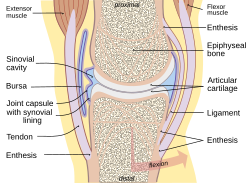Synovial bursa
| Synovial Bursa | |
|---|---|

Typical joint
|
|

Within the knee joint: bursae visible top right, middle right and bottom right
|
|
| Details | |
| Identifiers | |
| Latin | bursa synovialis |
| MeSH | Bursa,+Synovial |
| Code | TH H3.03.00.0.00039 |
| Dorlands /Elsevier |
b_27/12201211 |
| TA | A03.0.00.039 |
| FMA | 9692 |
|
Anatomical terminology
[]
|
|
A bursa (plural bursae or bursas) is a small fluid-filled sac lined by synovial membrane with an inner capillary layer of viscous synovial fluid (similar in consistency to that of a raw egg white). It provides a cushion between bones and tendons and/or muscles around a joint. This helps to reduce friction between the bones and allows free movement. Bursae are found around most major joints of the body.
There are four types of bursa: adventitious, subcutaneous, synovial, and sub-muscular. Among these, only adventitious is non-native. When any surface of the body is subjected to repeated stress, an adventitious bursa develops under it. Examples are Students' elbow and bunion.
Infection or irritation of a bursa leads to bursitis (inflammation of a bursa). The general term for disease of bursae is "bursopathy."
Bursa is Latin for purse, so named for the resemblance of an anatomical bursa to a purse. Bursae or bursas is its plural form.
...
Wikipedia
